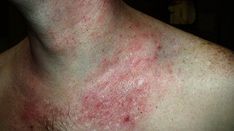Abstract and Introduction
Abstract
Background: Palmoplantar pustulosis (PPP) is a pruritic, painful, recurrent, and chronic dermatitis with limited therapeutic options.
Objective: To evaluate the efficacy and safety of apremilast for the treatment of Japanese patients with PPP and inadequate response to topical treatment.
Methods: This phase 2, randomized, double-blind, placebo-controlled study enrolled patients with Palmoplantar Pustulosis Area and Severity Index (PPPASI) total score ≥ 12 and moderate or severe pustules/vesicles on the palm or sole (PPPASI pustule/vesicle severity score ≥ 2) at screening and baseline with an inadequate response to topical treatment. Patients were randomized (1:1) to apremilast 30 mg twice daily or placebo for 16 weeks, followed by a 16-week extension phase during which all patients received apremilast. The primary endpoint was achievement of PPPASI-50 response (≥ 50% improvement from baseline in PPPASI). Key secondary endpoints included change from baseline in PPPASI total score, Palmoplantar Pustulosis Severity Index (PPSI), and patient's visual analog scale (VAS) for PPP symptoms (pruritus and discomfort/pain).
Results: A total of 90 patients were randomized (apremilast: 46; placebo: 44). A significantly greater proportion of patients achieved PPPASI-50 at week 16 with apremilast versus placebo (P = 0.0003). Patients receiving apremilast showed greater improvement in PPPASI at week 16 versus placebo (nominal P = 0.0013), as well as PPSI and patient-reported pruritus and discomfort/pain (nominal P ≤ 0.001 for all). Improvements were sustained through week 32 with apremilast treatment. The most common treatment-emergent adverse events included diarrhea, abdominal discomfort, headache, and nausea.
Conclusions: Apremilast treatment demonstrated greater improvements in disease severity and patient-reported symptoms versus placebo at week 16 in Japanese patients with PPP with sustained improvements through week 32. No new safety signals were observed.
ClinicalTrials.gov: NCT04057937.
Introduction
Palmoplantar pustulosis (PPP) is a pustular eruption characterized by a combination of intra-epidermal vesicles, pustules, erythema, and scales/desquamation located on the palms and soles.[1,2] PPP is characterized by intra-epidermal infiltration of polymorphonuclear neutrophils resulting in sterile pustules.[3] Patients with PPP have elevated levels of tumor necrosis factor (TNF)-α, interleukin (IL)-17, IL-22, IL-8, IL-1, and IL-36 in skin lesions.[4,5] PPP is rare, with a prevalence of 0.12% in Japan.[6] PPP lesions are often pruritic and/or painful.[7] Other symptoms of PPP include painful fissures.[1] These symptoms can be chronic, repeating relapsing, or remitting, and they may be disabling and severely impair quality of life.[2,7–10] Although PPP is very similar to palmoplantar pustular psoriasis (PPPP), some evidence has indicated that the two are genetically distinct.[11,12] For example, psoriasis is correlated with the HLA-Cw6 allele, but PPP is not, and the incidence of mutations in the IL-36 receptor antagonist gene (IL36RN) is much greater in generalized pustular psoriasis than in PPP.[12,13] Thus, it is still unclear whether PPP and PPPP are distinct or the same.
Treatment for PPP includes topical treatments (e.g., corticosteroids and active vitamin D3), oral systemic treatments (e.g., acitretin or etretinate, cyclosporine, methotrexate), phototherapy, biologic injectable treatments, and granulocyte and monocyte adsorption apheresis.[7,14–19] However, many of these treatments are contraindicated in certain patient populations and are associated with side effects ranging from skin atrophy with corticosteroids to increased risk of malignancy with phototherapy and biologics.[7] In addition, PPP can be very recalcitrant, and many patients with PPP do not fully respond to their treatment, highlighting an unmet medical need in this patient population.[7]
Apremilast is an oral phosphodiesterase 4 (PDE4) inhibitor that has demonstrated efficacy and tolerability for the treatment of psoriatic arthritis and plaque psoriasis, including palmoplantar psoriasis.[20–28] PDE4 degrades cyclic 3',5'-adenosine monophosphate (cAMP), a key regulator of inflammatory signaling. Inhibition of PDE4 with apremilast causes an increase in cAMP, which inhibits production of several inflammatory cytokines that are related to the pathogenesis of PPP, such as TNF-α, IL-17, IL-22, and IL-8.[1,4,29] Due to its mechanism of action and efficacy in other cytokine-mediated diseases,[24–28,30] apremilast theoretically may also be an effective treatment for PPP. However, until this study, the efficacy and safety of apremilast for the treatment of PPP had not been studied in randomized, placebo-controlled clinical trials. This randomized, phase 2 study (NCT04057937) evaluated the efficacy and safety of apremilast versus placebo for the treatment of patients with PPP after inadequate response to topical treatment in Japan.
Am J Clin Dermatol. 2023;24(5):837-847. © 2023 Adis Springer International Publishing AG












